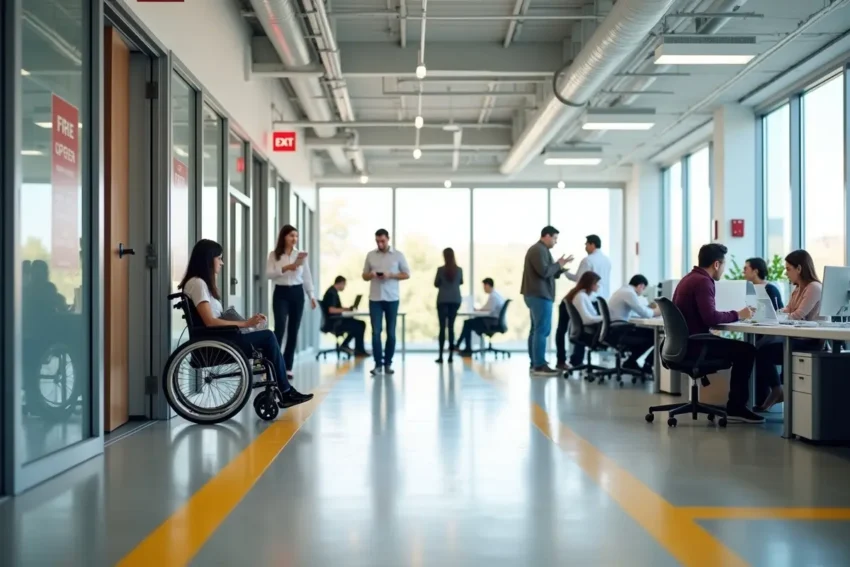Workplace Safety Through the Lens of Accessibility

Creating an inclusive work environment goes beyond merely meeting legal requirements. It encompasses fostering a culture of safety that benefits every employee. When organizations prioritize workplace safety through the lens of accessibility, they create an environment where individuals, regardless of their abilities, can thrive.
The emphasis on accessibility leads to thoughtful considerations regarding physical layouts, safety protocols, and resource allocation, ensuring everyone’s well-being is taken into account. By examining workplace safety with an accessibility focus, companies can enhance productivity and morale across their workforce.
Contents
- 1 The Importance of Accessibility in Workplace Safety
- 2 Understanding Diverse Needs
- 3 Training and Awareness Programs
- 4 Physical Changes and Accessibility Enhancements
- 5 Emergency Preparedness and Accessibility
- 6 Fostering a Culture of Inclusion
- 7 Measuring and Adapting Safety Policies
- 8 Leveraging Technology for Accessibility and Safety
- 9 The Business Benefits of Prioritizing Accessible Safety
The Importance of Accessibility in Workplace Safety
Accessibility should be at the forefront of discussions surrounding workplace safety. Much of the traditional safety training focuses on generic solutions that may overlook specific needs of employees with disabilities. A person using a wheelchair may have different safety concerns compared to a sight-impaired individual.
Implementing strategies and solutions that cater to various abilities helps create a safer environment. Studies have shown that organizations that integrate accessibility measures into their safety protocols experience a reduction in accidents and injuries. An estimated 25% of adults in the United States live with some form of disability, and their unique challenges necessitate comprehensive safety solutions.
Understanding Diverse Needs
A key factor in fostering safety and accessibility in the workplace is understanding the diverse needs of employees. Organizations can conduct assessments to identify specific challenges faced by workers with physical, sensory, or cognitive disabilities.
Through open dialogue and surveys, employees can express their concerns, leading to tailored safety measures. Visible signage with braille or auditory alarms can significantly enhance safety for visually impaired individuals. Providing ergonomic workspaces helps accommodate those with musculoskeletal ailments. Such solutions contribute to a more inclusive work culture.
Training and Awareness Programs
Implementing effective training programs is crucial in ensuring that all employees understand accessibility and safety measures. Comprehensive training should address traditional safety protocols and incorporate specific accessibility needs and considerations. Providing workplace accident prevention tips for individuals with diverse disabilities can equip them with the knowledge to navigate their work environment safely.
Regular training refreshers are important, reinforcing safety protocols and ensuring that all employees stay updated on the best practices. By fostering a culture of awareness and education, companies empower their workforce to take proactive roles in their safety and the safety of their colleagues.
Physical Changes and Accessibility Enhancements
Adapting the physical work environment to accommodate different needs is vital in reinforcing workplace safety. Simple modifications, such as installing ramps and handrails, can significantly improve accessibility for individuals with mobility challenges. Clear pathways free from obstructions are important to prevent accidents and facilitate navigation.
Other enhancements, such as lowering countertops or incorporating adjustable desks, ensure that everyone can work comfortably and efficiently, aligning with their personal needs. Making physical changes also encompasses the incorporation of assistive technologies that provide additional support, from screen readers for the visually impaired to auditory devices for hearing-impaired individuals.
Emergency Preparedness and Accessibility
Emergency preparedness plans must consider the specific needs of individuals with disabilities. Organizations should ensure that all safety exits and evacuation routes are accessible to everyone. The importance of staff training in assisting individuals with disabilities during emergencies cannot be overstated.
Regular drills that include diverse scenarios can provide invaluable practice for all employees. Clear communication regarding emergency protocols can be tailored for employees with cognitive difficulties, ensuring they understand the instructions effectively. By planning for emergencies with accessibility in mind, companies can significantly enhance the safety of their work environment.
Fostering a Culture of Inclusion
Creating a culture of inclusion is crucial for promoting workplace safety through accessibility. Open communication between management and employees encourages the sharing of insights and improvement suggestions. Establishing a safety committee with diverse representation can ensure that varied perspectives are considered in safety policies and practices.
By valuing every employee’s input, organizations can foster an environment where individuals feel empowered to voice their concerns and participate in safety initiatives. Leadership plays a crucial role in modeling inclusive behavior and actively demonstrating their commitment to safety and accessibility, which can significantly enhance employee morale and loyalty.
Measuring and Adapting Safety Policies
To ensure the effectiveness of safety policies, organizations must regularly measure and adapt their strategies. Collecting data on accidents, near misses, and employee feedback is crucial for evaluating the current safety policies. By identifying patterns and trends, companies can focus on areas that require enhancement and dedicate resources efficiently.
Adapting safety measures to reflect diverse employee needs demonstrates a commitment to continuous improvement. Engaging with external experts or partnering with accessibility organizations can provide further insights and innovative solutions to enhance workplace safety.
Leveraging Technology for Accessibility and Safety
Technology is revolutionizing how organizations approach workplace safety and accessibility. Tools such as voice-activated systems, wearable safety devices, and mobile applications can significantly improve the working environment for employees with disabilities.
Apps that provide real-time alerts during emergencies or wearable sensors that detect hazards can empower workers to act quickly and safely. Digital platforms can be used to provide accessible training materials, such as captioned videos or interactive modules designed for people with cognitive challenges. By leveraging technology, companies can bridge accessibility gaps while simultaneously raising safety standards across the board.
The Business Benefits of Prioritizing Accessible Safety
While accessibility in safety measures is often framed as a moral and legal responsibility, it delivers clear business advantages. Companies that actively integrate accessibility into their safety culture often experience higher employee satisfaction, reduced turnover, and enhanced productivity. Employees who feel safe and included are more engaged and motivated in their work.
Organizations with strong accessibility practices often earn reputational benefits, appealing to socially conscious clients, partners, and job seekers. By treating accessibility as a strategic business asset rather than an afterthought, companies create a competitive edge while cultivating a supportive and secure work environment.
Workplace safety viewed through the lens of accessibility is not just about compliance; it’s about creating an environment where all employees can thrive. By recognizing diverse needs, enhancing training, making physical adjustments, and leveraging technology, organizations can build safer and more inclusive workspaces.
Preparing for emergencies and continuously adapting policies ensures that accessibility remains at the core of safety strategies. Beyond meeting obligations, these efforts foster a culture of respect and inclusion, benefiting both employees and the business as a whole. Prioritizing accessibility in workplace safety is an investment in people, productivity, and long-term organizational success.



